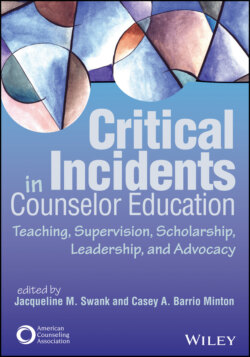Читать книгу Critical Incidents in Counselor Education - Группа авторов - Страница 78
2014 ACA Code of Ethics Standards Addressed
ОглавлениеF.9.a. Evaluation of Students
F.11.b. Student Diversity
F.11.c. Multicultural/Diversity Competence
• • •
Jessica, a white woman, was an assistant professor with several years of school counseling and teaching experience. Veronica, a Latinx woman, was a third-year counselor education doctoral student and a practicing school counselor. Jessica and Veronica were coteaching the spring Classroom Management, Collaboration, and Consultation course for school counseling students. Jessica was the instructor of record, and Veronica was the teaching assistant.
Jessica and Veronica used a constructivist teaching style for the course. Their goal was to be student centered. They designed class activities to align with learning objectives, the 2016 Council for Accreditation of Counseling and Related Educational Programs (CACREP) Standards, experiences at internship sites, and students’ own personal life experiences. The course included both didactic and experiential components. Jessica and Veronica shared responsibility for presenting content and facilitating activities throughout the semester. There were also several sociopolitical factors to consider at the time, including Donald Trump’s presidency; mass shootings in schools in Florida, Texas, and Southern California; targeted arson attacks on African American churches in the Southeast; and the continued advancement of movements like Black Lives Matter and Me Too.
Students were in the second year of the school counseling master’s program. They were in the final phase of their training and entering their first semester of internship. The cohort consisted of 16 women, most of whom were in their middle to late 20s; four students identified as second-career students. The cohort was split demographically, with a little less than half self-identifying as students of color and a little more than half self-identifying as white. All students in the cohort took core courses together and had navigated the school counseling program with minimal overt conflict up to this point. However, the instructors observed several incidents that implied underlying tensions within the cohort. White students and students of color self-segregated during in-class activities, during group work, and outside class.
For the second to last class meeting, Jessica and Veronica planned a video and group discussion. Jessica played a video that presented a white school counselor who incorporated inclusion into her classroom management to engage students who felt excluded or disinterested. The school counselor’s use of classroom management skills ultimately led to a positive relationship with a Black student who had previously been disengaged, uninterested in the classroom, and frequently in trouble. The video continued to highlight the school counselor’s role in supporting the student’s success.
After the video ended, Jessica attempted to lead a discussion on strategies used by the school counselor. Beatrice, a 27-year-old self-identified African American woman, described her disappointment and frustration toward white peers who glorified the school counselor for helping the Black student. Some white students explained their hesitation in speaking up about topics related to marginalized communities. What followed was a broader conversation around cohort dynamics related to race/ethnicity, expectations of school counselors for advocating for and supporting students with marginalized identities, and the disappointment felt by all students.
A few students of color explained that they felt they had to serve as spokespeople for their racial groups. They shared that they felt dismissed by white students who did not make an effort to understand the lived experiences of people of color or build genuine connections with cohort members who did not look like them. Amy, a 23-year-old white woman, explained that she was tired of having discussions of multicultural awareness because she did this all day at her internship site and did not see why the conversation was necessary in the classroom. Amy proceeded to put on her jacket and beanie, and she physically disengaged from the conversation.
Jessica and Veronica worked to address comments about the need for multicultural awareness and tried to maintain a space in which this conversation could continue. They were also having reactions to cohort dynamics, each other, and the topics discussed. Their intention behind explaining the importance of multicultural awareness was twofold: to relate the conversation to their work with diverse students and staff in schools and to remind students that the work was ongoing at both personal and professional levels. Veronica was frustrated, and she was afraid that if she expressed her opinion about what Amy had just said, it would have been fueled by emotion in a way that would not have been beneficial to the learning environment.
Following Amy’s comment, a few students of color expressed frustration and disappointment with cohort members of the dominant culture. Students of color diverted the conversation to matters about their lived experiences, isolation within the cohort, and sadness about the disconnect between cohort members in and outside class. The group spent the remainder of the class processing feelings and thoughts around the cohort rupture, race relations, and their work as school counselors. By the end of the class, no clear conclusion had been reached. It felt like Jessica and Veronica were outsiders in this conversation as they watched the group take the lead and go where they needed to go while also trying to ensure no harm was done. Following class, Jessica and Veronica processed what had happened and were perplexed as to how to move forward with only one class session remaining before this cohort moved on in the program.
